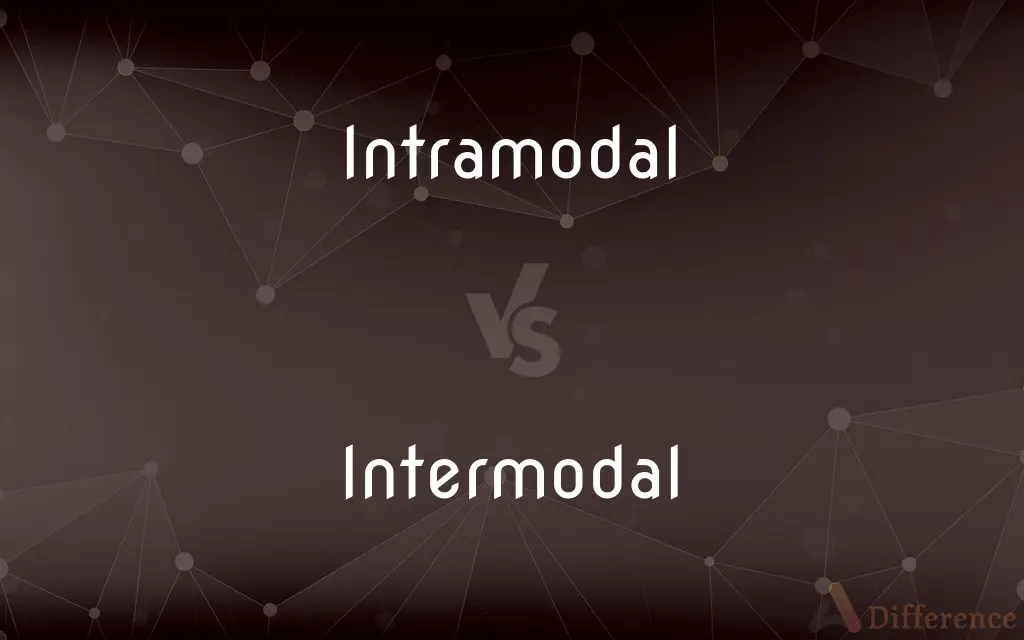Intramodal vs. Intermodal — What's the Difference?
By Urooj Arif & Maham Liaqat — Updated on March 30, 2024
Intramodal transportation refers to the movement of goods or passengers within a single mode of transport, while intermodal involves transferring between different modes.

Difference Between Intramodal and Intermodal
Table of Contents
ADVERTISEMENT
Key Differences
Intramodal transportation is focused on the movement of goods or passengers using a single mode of transport, such as rail, road, sea, or air, without any change in the mode during the journey. This approach is often chosen for its simplicity and can be more efficient for shorter distances or when a single mode is clearly advantageous. On the other hand, intermodal transportation involves transferring goods or passengers between different modes of transport during their journey, such as from truck to ship, or train to airplane. This method is advantageous for optimizing routes, costs, and reducing environmental impact by leveraging the strengths of different transportation modes.
Intramodal transportation can lead to specialization and efficiency within a particular mode, as operators and logistics companies can focus on optimizing their services, infrastructure, and technology for that specific mode. Conversely, intermodal transportation requires coordination and integration between different transportation modes, which can add complexity but also provides flexibility in choosing the most efficient, cost-effective, and environmentally friendly options for long-distance and international shipments.
One of the main advantages of intramodal transport is the potential for streamlined operations and lower handling costs, as goods or passengers do not need to be transferred between different modes. This can result in faster delivery times and reduced risk of damage or delays. In contrast, intermodal transport, despite involving more logistics and potential handling, can significantly reduce transportation costs and environmental impact by combining the efficiencies of different modes, such as using rail for long distances and trucks for last-mile delivery.
Intermodal transportation also offers greater flexibility in responding to changing transportation needs, such as shifts in trade routes, environmental regulations, or fuel prices. It allows shippers to adapt quickly by changing the combination of modes used, whereas intramodal transportation is more fixed in its routes and capacities.
Despite the complexities involved, intermodal transportation has been growing in popularity due to its potential for cost savings, reduced environmental footprint, and increased resilience in the supply chain. It is particularly well-suited for global trade, where goods often need to travel long distances and across various terrains. Intramodal transportation, while less flexible, remains a vital component of the global transportation ecosystem, especially for specialized, time-sensitive, or high-value shipments that benefit from the continuity of a single mode.
ADVERTISEMENT
Comparison Chart
Definition
Movement within a single mode of transport.
Movement involving transfers between different modes of transport.
Efficiency
Can be more efficient for shorter distances or specific needs.
Optimizes efficiency and cost for long-distance shipments.
Complexity
Lower, due to the lack of mode transfers.
Higher, due to the need for coordination between modes.
Cost
Lower handling costs, but potentially higher mode-specific costs.
Potentially lower overall costs through mode optimization.
Environmental Impact
Can be higher if less efficient modes are used exclusively.
Often lower, by leveraging the most efficient mode for each segment.
Compare with Definitions
Intramodal
Can be more efficient and quicker for short to medium distances.
For intracity deliveries, intramodal road transportation is the most efficient.
Intermodal
Transport involving the transfer of goods or passengers between different transportation modes.
The shipment was transported intermodally, from truck to ship, then from ship to rail.
Intramodal
Transport of goods or passengers using only one mode, without any transfers.
The goods were shipped intramodally by truck directly to their destination.
Intermodal
Often more cost-effective for long-distance and international shipments.
Using intermodal transportation can reduce costs significantly by utilizing rail for major hauls.
Intramodal
Encourages optimization and specialization in a particular mode.
Intramodal shipping companies often specialize in specific types of railcars.
Intermodal
Allows for route optimization and adaptation to changing needs.
Intermodal transportation offers the flexibility to switch from rail to road transport easily.
Intramodal
Potentially higher costs for long distances due to the limitations of a single mode.
Intramodal air freight is fast but can be costly for international shipping.
Intermodal
Reduces carbon footprint by leveraging the most efficient transport mode for each segment.
Intermodal transport minimizes environmental impact by combining rail and truck transport efficiently.
Intramodal
Offers a straightforward logistics process due to the use of a single mode.
Intramodal rail transport made the coordination of the shipment simpler.
Intermodal
Requires significant coordination between various transportation providers.
Successful intermodal transport depends on seamless coordination at transfer points.
Intramodal
Within a mode.
Intermodal
Relating to transportation by more than one means of conveyance, as by truck and rail
Intermodal transport.
Intermodal
Relating to more than one mode of transport.
An intermodal station which provides transfers between buses and trains
Common Curiosities
Can intermodal transportation be more cost-effective than intramodal?
Yes, intermodal can be more cost-effective for long distances by utilizing the most efficient transport mode for each segment.
What is intramodal transportation?
Intramodal transportation refers to the movement of goods or passengers within a single mode of transport without transfers.
How does intramodal transportation impact supply chain logistics?
Intramodal can simplify supply chain logistics by avoiding the complexities of coordinating multiple transport modes.
What are the environmental benefits of intermodal transportation?
Intermodal reduces environmental impact by combining efficient modes, such as using rail for long hauls, which is less polluting than road transport.
What is intermodal transportation?
Intermodal transportation involves transferring goods or passengers between different modes of transport during their journey.
What role does government regulation play in intermodal transportation?
Government regulations can impact intermodal transportation by setting standards for safety, environmental compliance, and interoperability between modes.
Which is more complex to manage, intramodal or intermodal transportation?
Intermodal transportation is more complex due to the need for coordination between different transport modes.
What challenges are associated with intermodal transportation?
Challenges include the need for effective coordination, potential delays at transfer points, and managing different logistics services.
Can intramodal transportation be used for international shipments?
It's less common due to the limitations of certain modes over long distances, but possible if a single mode, like maritime, covers the entire route.
How do intramodal and intermodal transportation differ in terms of efficiency?
Intramodal can be more efficient for shorter distances or when a single mode is advantageous, while intermodal optimizes long-distance shipments by combining modes.
Why might a company choose intramodal transportation?
A company might choose intramodal for its simplicity, speed, and when a single mode meets their specific transportation needs effectively.
How do technological advancements impact intermodal transportation?
Technological advancements improve coordination, tracking, and efficiency, making intermodal transportation more seamless and reliable.
Share Your Discovery

Previous Comparison
Threshing vs. Winnowing
Next Comparison
Composite vs. HybridAuthor Spotlight
Written by
Urooj ArifUrooj is a skilled content writer at Ask Difference, known for her exceptional ability to simplify complex topics into engaging and informative content. With a passion for research and a flair for clear, concise writing, she consistently delivers articles that resonate with our diverse audience.
Co-written by
Maham Liaqat















































